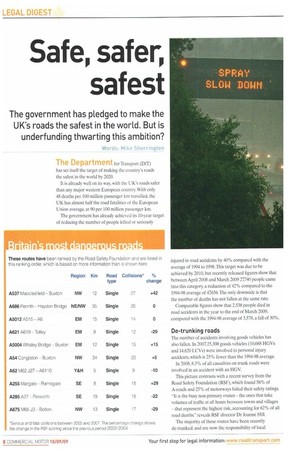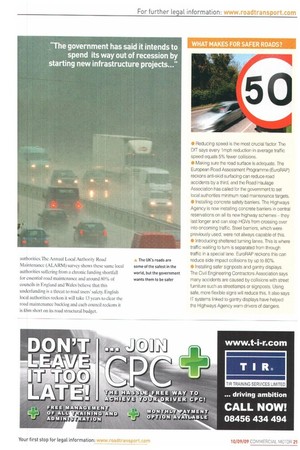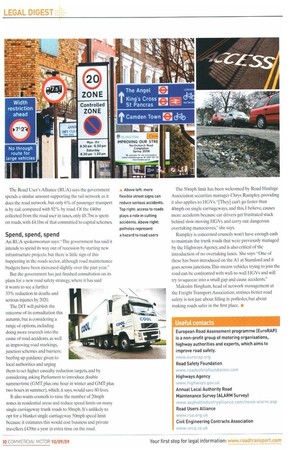Safe, safer, safest
Page 28

Page 29

Page 30

If you've noticed an error in this article please click here to report it so we can fix it.
The government has pledged to make the UK's roads the safest in the world. But is underfunding thwarting this ambition?
Words: Mike Sherrington
The Department for Transport (DfT) has set itself the target of making the country's roads the safest in the world by 2020.
It is already well on its way, with the UK's roads safer than any major western European country. With only 48 deaths per 100 million passenger km travelled, the UK has almost half the road fatalities of the European Union average, at 90 per 100 million passenger km.
The government has already achieved its 10-year target of reducing the number of people killed or seriously These routes have been ranked by the Road Safety Foundation and are listed in injured in road accidents by 40% compared with the average of 1994 to 1998. This target was due to be achieved by 2010, but recently released figures show that between April 2008 and March 2009 27,740 people came into this category, a reduction of 42% compared to the 1994-98 average of 47,656. The only downside is that the number of deaths has not fallen at the same rate.
Comparable figures show that 2,538 people died in road accidents in the year to the end of March 2009. compared with the 1994-98 average of 3,578, a fall of 30%.
De-trunking roads
The number of accidents involving goods vehicles has also fallen. In 2007,25,308 goods vehicles (10,688 HGVs and 14,620 LCVs) were involved in personal injury accidents, which is 25% fewer than the 1994-98 average.
In 2008.8.3% of all casualties on trunk roads were involved in an accident with an HGV.
This picture contrasts with a recent survey from the Road Safety Foundation (RSF), which found 58% of A-roads and 25% of motorways failed their safety ratings. "It is the busy non-primary routes the ones that take volumes of traffic at all hours between towns and villages that represent the highest risk, accounting for 62% of all road deaths," reveals RSF director Dr Joanne Hill.
*Serious and fatal collisions between 2005 and 2007, The percentage change shows The majority of these routes have been recently the change in the RSF scoring since the previous period 2002-2004 de-trunked, and are now the responsibility of local
authorities. The Annual Local Authority Road Maintenance (ALARM) survey shows these same local authorities suffering from a chronic funding shortfall for essential road maintenance and around 80% of councils in England and Wales believe that this underfunding is a threat to road users' safety. English local authorities reckon it will take 13 years to clear the road maintenance backlog and each council reckons it is £6m short on its road structural budget. The Road User's Alliance (RUA) says the government spends a similar amount supporting the rail network as it does the road network, but only 6% of passenger transport is by rail, compared with 92% by road. Of the f46bn collected from the road user in taxes, only f8.7bn is spent on roads, with f4.1bn of that committed to capital schemes.
Spend, spend, spend An RUA spokeswoman says: "The government has said it intends to spend its way out of recession by starting new infrastructure projects, but there is little sign of this happening in the roads sector, although road maintenance budgets have been increased slightly over the past year."
But the government has just finished consultation on its plans for a new road safety strategy, where it has said it wants to see a further 33% reduction in deaths and serious injuries by 2020.
The DtT will publish the outcome of its consultation this autumn, but is considering a range of options, including doing more research into the cause of road accidents, as well as improving road markings, junction schemes and barriers: beefing up guidance given to local authorities and urging them to set higher casualty reduction targets, and by considering asking Parliament to introduce double summertime (GMT plus one hour in winter and GMT plus two hours in summer), which, it says, would save 80 lives.
It also wants councils to raise the number of 20mph zones in residential areas and reduce speed limits on many single carriageway trunk roads to 50mph. It's unlikely to opt for a blanket single carriageway 50mph speed limit because it estimates this would cost business and private travellers £439m a year in extra time on the road. The 50mph limit has been welcomed by Road Haulage Association securities manager Chrys Rampley, providing it also applies to HGVs. "[They] can't go faster than 40mph on single carriageways, and this, I believe, causes more accidents because car drivers get frustrated stuck behind slow-moving HGVs and carry out dangerous overtaking manoeuvres," she says.
Rampley is concerned councils won't have enough cash to maintain the trunk roads that were previously managed by the Highways Agency, and is also critical of the introduction of no overtaking lanes. She says: "One of these has been introduced on the Al at Stamford and it goes across junctions. This means vehicles trying to join the road can be confronted with wall-to-wall HGVs and will try to squeeze into a small gap and cause accidents."
Malcolm Bingham, head of network management at the Freight Transport Association, stresses better road safety is not just about filling in potholes, but about making roads safer in the first place. •




















































































































































